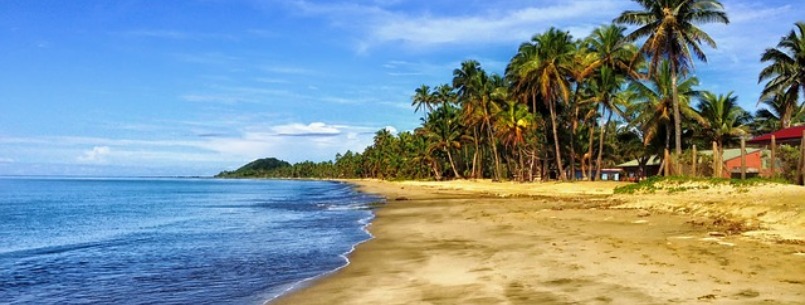Fiji Vacation Guide
The name Fiji is synonymous with paradise. The beautiful South Pacific group consists of some 300 islands and atolls dotted across 200,000 square miles of sea. The main island is Viti Levu, the second largest is Vanua Levu, and together they make up 85% of the country’s total land area. All the islands have picturesque coasts, tall coconut palms nodding over still waters of brilliant turquoise lagoons fringed by coral reefs and white silky soft sandy beaches.
Fiji Sightseeing
Vegetation is mainly tropical coconut palms and the pandanus interspersed with hibiscus, frangipani and other exotic flowers. Unique fauna includes the fruit bat, mongoose, and Fijian crested iguana. On the road from Suva to Nadi are the kula bird park and the Sigatoka Sand Dune. In Suva, the National Museum stands right next to Government House with its colorful guards dressed in red tunics and white sulus. For those who like to explore, there is a central island bush trek through the province following the track which the missionaries took in 1849.
In Suva, delight at the huge selection of the freshest Fijian fruits and seafood at The Marlin Bar and Nautilus Restaurant which provide an international range of foods and beverages. The weekly Lovo night, where you cannot only sample local delicacies but be treated to authentic Fijian entertainment, is an absolute must.
The beach provides an excellent playground for boating, sailing, windsurfing, snorkeling, diving and big game fishing. The resort has its own deep-sea fishing boat, JP Princess, plus a catamaran and glass-bottomed boat for guest cruises. A wide range of activities on land includes horse riding, golf (special rates for guests) and tennis. Bookings can be made at reception for a number of popular excursions including a day trip up the Navua River to swim in a crystal clear waterfall and a cruise to Yanuca Island.
The Kids Only (KO) Club caters for children aged from 2-12 years and provides an insight into other Fijian culture through a variety of indoor and outdoor activities.
Step into another time – Fijian time – at Centra Resort where your every comfort is attended to by the friendly smiling staff, reminding you that you have arrived in a holiday paradise.
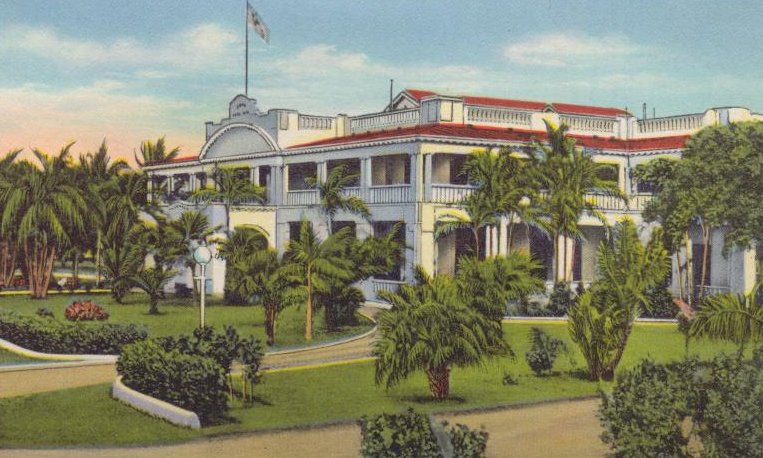
Fiji Accommodations
Accommodation is prolific – something for every budget from luxury hotels, resorts and villas to Fijian Bures with modern facilities, cottages, lodges, townhouses, and apartments. Campsites are also available. There are a variety of rental car agencies, and extensive local bus service on each of the main Islands, deluxe coach tours, and taxis.
Grand Pacific Hotel
That grand “old lady” of Suva, Fiji, the Grand Pacific Hotel, had provided accommodation for many years for travelers who appreciated the fine service offered. Sadly, this once-grand hotel has now become a vacant derelict building. In this respect, it is most pleasing to hear that the Grand Pacific Hotel has now been handed back to the Fiji government with the aim of restoring her to her former glory! What follows is a nostalgic trip down memory lane to have a look at some images of this grand “old lady”! I do hope that you enjoy this journey back in time.
Treasure Island Resort
Treasure Island Resort is a fifteen-acre reef fringed atoll about 13 kilometers to the northwest of Nadi Airport. As the resort covers the entire island, the 67 well-appointed bures are located around the perimeter giving all a beachfront. All the spacious bures are air-conditioned, have ceiling fans, and ensuite, a refrigerator, and tea and coffee making facilities. There is ample fresh hot and cold running water piped from the mainland but no telephones, except in the office, no television and no radio. The rooms and patio are simply decorated in tropical style with pastel colors and rattan furnishings. The magnificent high ceilinged, solidly constructed main bure houses the restaurant, The Takia Bar as well as the dance area where the band plays every night. The well-stocked boutique is nearby. The games and convention bure next door seats around 90 people theatre style and is ideal for a small conference or business seminar. Casually elegant, the tropical dining room serves wholesome, well presented, reasonably priced meals. Apart from the art of relaxing poolside or on the beach, activities include sailing, canoeing, pedal boats, snorkeling, parasailing, tennis, and mini golfs or a game of volleyball with the staff – Fiji vs Rest of the world! No motorized activities are free. There is a full scuba diving operation on the island as well as game fishing while hand line fishing is available early morning and evening, free of charge.
Plantation Resort
Plantation Resort is situated on Malolo Lai Lai Island in the fabulous Mamanuca Group of islands west of Nadi Bay. The resort is nestled among 25 acres of tropical coconut palms and boasts seven kilometers of pristine white sandy beach, part of which fronts the beautiful sheltered aqua lagoon. Plantation Island offers a choice of large two-bedroom beachfront or garden bures, one-bedroom bures or hotel rooms with either beach or garden views. All accommodation features, private bathrooms, overhead fans, IDD telephone, refrigerator, and tea/coffee making facilities.
Plantation Island is an aquatic paradise with all non-motorized water sports free of charge to house guests including catamarans, windsurfers, canoes and snorkeling equipment. Motorized water sports include water skiing, para-flying, big banana, jet skis, deep-sea fishing, hand line fishing, dolphin watching, surfing and PADI scuba diving which will bring you face to face with the spectacular underwater life, some of which is unique to Fiji. Families holidaying on Plantation Island are always delighted to discover the children’s creche, interesting activity program, playground, kids pool with slide and reasonable babysitting prices. The friendly Fijian hospitality ensures that you will leave Plantation Resort with the kind of memories that will bring you back soon.
Beachcomber Island Resort
A leisurely hour’s cruise from Lautoka takes you to the golden sands and tropical scenery of Beachcomber island where life is carefree, casual, and comfortable. In keeping with the relaxed atmosphere, you will find accommodation suited to every budget with the choice of private Fijian bure, the Grand Bure, or the lodge. The bures have traditional thatched roofs, private deck with sun lounges and include private facilities, fridge, tea and coffee maker, and ceiling fan. The Grand Bure is the largest and strongest traditional bure in all of Fiji and provides affordable dormitory-style accommodation with shared facilities as well as a unique way to meet people from all over the world. For the budget-conscious, the lodge includes two beds with private facilities, vanity, basin, tea an coffee making facilities, fridge and fan. All meals are included in the daily tariff and in true island style, the traditional beating of drums signals leisurely meal times where you can savor the selection of Fijian and international dishes served buffet style. Complimentary resort activities include coral viewing, snorkeling, volleyball, mini-golf, fish feeding, and cultural floor shows four nights a week. Other aquatic activities available include a semi-submersible submarine, coral reef viewing, windsurfing, fishing, canoeing, sailing, jet skis, and parasailing, as well as scuba diving and instructions.
Getting to Beachcomber Island is easy, as the resort can arrange transport to and from Nadi airport and hotels to connect with your transfer from Lautoka wharf to the island eleven miles offshore. Once having stepped ashore, Beachcomber Island Resort’s charm makes it very hard to leave.
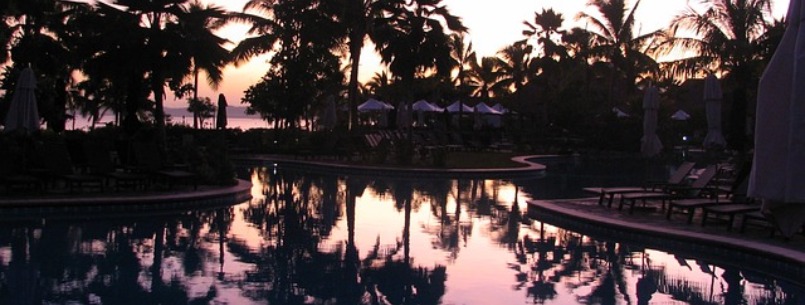
Fiji Food & Entertainment
Nightclubs, restaurants, and cinemas are located in the city centers with most big hotels providing their own entertainment in the form of Fijian nights which include underground cooking and sometimes kava drinking and always some songs and dance. Water-based activities abound including scuba diving, game fishing, surfing, windsurfing, sailing, cruising and yacht charters. On land choose from golf, horse-riding, squash, rugby, bushwalking, shell gathering and numerous island tours.
When to Visit Fiji
Best visited during the cooler dryer season from May to October, Fiji offers the visitor a wide range of memorable experiences that remain forever and which will always beckon the visitor to forever long to return to these beautiful islands.
Fiji still acts as a magnet for holidaymakers and visitors from all around the world who come to enjoy the many attractions and relaxed lifestyle that Fiji has to offer. The capital, Suva, is sprawled over a hilly peninsula and enjoys a magnificent seafront setting. After some years of upheaval, Suva now has its bustle back and visitors can enjoy sightseeing, shopping and the marvelous food and nightlife.
There are plenty of reminders of the colonial era in Suva including the former Garrick Hotel, the Fiji Visitors Bureau, the old Town Hall and the FINTEL building. Once elegant, the waterfront Grand Pacific Hotel remains boarded up awaiting restoration. Traveling south along Victoria Parade, visitors can view the Thurston Gardens, founded by a pioneer botanist. Within these gardens is the Fiji Museum whose treasures include the solitary boot belonging to the reckless Reverend Baker who once ended up as someone’s dinner. There is also a hall full of the bark cloth (tapa) in which Fijian chiefs used to be swathed.
Fiji Shopping
Bargaining is still conducted in some shops, but the larger stores have fixed prices. Fijian artifacts are available from Suva handicrafts on Stinson Parade and from roadside stalls and Indian bazaars. Shopping hours are Monday to Thursday 8 a.m. to 5 p.m., and on Fridays, most shops close at 6 p.m. On Saturdays, a number of shops stay open for half a day.
Suva is a shopper’s paradise where one can find rows of dusty little storefronts crammed with electronics, drapery, and stationery. Popular souvenirs include beachwear as Fiji has a substantial garment industry. Other popular souvenirs are coconut-based soaps and lotions, woven raffia bags, kava bowls and statuettes.
Along Victoria Parade, the main street in Suva, one can find the brightly painted Victorian facades of the remnants of the grand old trading empires such as Morris Hedstrom, Carpenters or Burns Philp. The more adventurous can also find the ingredient for the traditional kava drink in piles of yaqona, the roots and stems of the kava plant. Also available are sackfuls of rich earthy Indian spices: orange saffron, cumin, panch phora, and garam masala.
To sample typical Fijian cuisine, it is worth visiting the upstairs food court at the Harbour Centre, opposite the gigantic Village Cinema. For those who prefer Indian food, try the Ashiyana in the old Town Hall building in Victoria Parade.
A wide range of accommodation is available in Suva from the budget-priced Raintree Lodge to the medium-priced Raffles Tradewinds to the upmarket Peninsula International Hotel.

Fiji Capital and Major Cities
The capital is Suva on the southeast corner of Viti Levu, although most visitors have their first taste of Fiji via the International Airport at Nadi, one of the other major towns. Nearby are the Mamanuca and Yasawa Islands that offer picture-postcard lagoons and beaches. The old capital of Levuka on Ovalau island has been preserved as a historical monument.
People of Fiji
Fiji is the “hub” of the South Pacific, a melting pot of both the Polynesian and Melanesian races. The nation comprises many different races and people, predominantly native Fijians and the descendants of indentured Indian laborers brought to the island to work in the plantations and sugar cane fields.
Fiji History
Fiji was probably first settled 3,500 years ago. Dutch explorers were the first European to arrive in 1643. Further exploration was made by Captain James Cook in 1774 and by Captain William Bligh who sailed through the group after the mutiny on the Bounty. In 1835, the missionaries arrived, introduced Christianity and ended cannibalism. In 1874, Fiji was ceded to Great Britain and Indian indentured laborers were introduced. Fiji finally gave independence in 1970 and declared itself a Republic on 7th October 1987. A draft constitution was introduced for a single-chamber parliament with 71 seats.
Suva, Fiji Visitors Guide
Suva is the capital of Fiji and is a beautiful harbor city built on a peninsula reaching out into the sea. Its tall modern buildings are beautifully balanced by rich traditional colonial architecture. The city is perched on a hilly peninsula between Laucala Bay and Suva Harbour in the southeast corner of Viti Levu. The mountains north and west catch the southeast trade winds, producing moist conditions year-round.
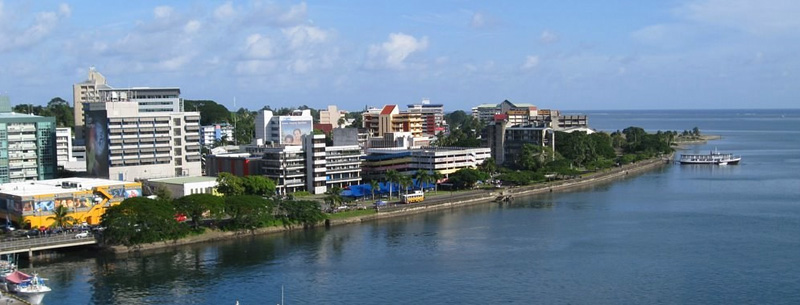
Mamanuca Islands – Fiji
The Mamanuca (pronounced Mah-mah-noo-tha) islands lie in a majestic arc, only a short distance from the mainland of Viti Levu, curving to the north-west, and almost touching the Yasawa chain. There are 13 islands in all, not counting those covered by the Pacific at high tide and they all share in common pristine white sandy beaches, waving palms, crystal blue waters and, at night, the cooling influence of the trade winds. The Manacus are essentially volcanic outcrops pushed up from the ocean floor in a gigantic earthquake thousands of years ago. Some are especially significant in Fijian folklore.
From the air, you can see that the Mamanucas group is, in fact, two clusters shown as Mamanuca-i-ra and Mama-nuca-i-cake. Within the Mamanucas is the Malolo group, three miles inside the barrier reef, extending in a curve for about 75 miles. A number of resort islands are scattered throughout the Malolo group, each offering comfortable casual bure (Fijian style cottage) accommodation, a relaxing holiday atmosphere and a range of water activities. There are boat excursions, fishing trips, and water sports including water skiing, windsurfing, snorkeling, diving, sailing, speed boat riding, and coral viewing.
Malololailai is the center for most tourism to and from the Mamanucas. It has safe anchorage, a cosmopolitan community of Fijians and Indians and an airstrip serviced regularly from Nadi. Other resort islands within the group include Beachcomber Island, Castaway Island, Malolo Island, Mana Island, Matamanoa Island, Musket Cove, Navini, Plantation Island, Tavarua Island, Treasure Island, and Tokoriki, which is located in the furthest from the mainland.
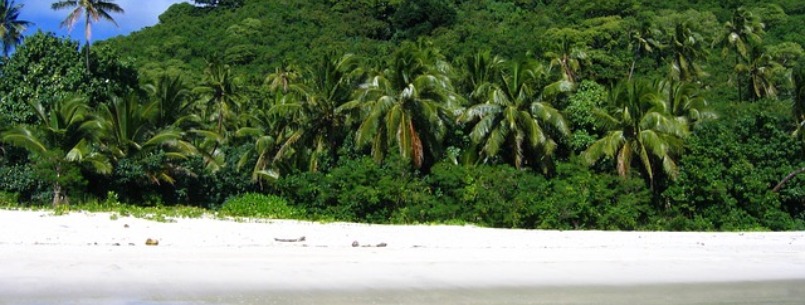
Yasawa Islands – Fiji
The Yasawa Islands have a different ambiance. They are a chain of 16 volcanic islands and dozens of tiny islets stretching 80 kilometers in a north-northeast direction off the west coast of Viti Levu. They are special because of their beautiful, isolated beaches, cliffs, bays and reefs, unspoiled by much tourist development. Because they sit in the lee of Viti Levu, the Yasawas are dry and many with crystal clear waters.
It was from the north end of the Yasawas that two canoe-loads of cannibals appe4ared in 1789 and gave Captain William Bligh and his 18 companions a chase, less than a week after the famous mutiny. Two centuries later, cruise ships ply the island chain and its waters, while more and more luxury resorts dot the islands’ foreshores. The group was romanticise4d in the movie “The Blue Lagoon” twice, once in 1949 with Jean Simmons and again in 1980 with Brooke Shields.
The islands of the group are Waya Island, the highest in the Yasawas, Tavewa Island, a strikingly beautiful small island about two kilometers long. Turtle Island, which has the ultimate resort owned by Richard Evanson who bought the island in 1972. Yasawa Island, Sawa-i-Lau Island with its large limestone cave illuminated by a crevice at the top, Naviti Island which is the largest of the Yasawa and Viwa, the most remote, squatting alone 25 kilometers northwest of Waya.
Fiji Northern Islands
Welcome to the Fiji Northern Islands! These include the beautiful and popular island resorts of Namare, Nukubati, Maravu Plantation, Taveuni, Matangi, Qamea and Moody’s Namena. The Northern Islands are for those who seek endless miles of squeaky clean white sandy beaches and crystal clear waters for scuba diving, since beneath the waves are some of the top dive spots in the world. They also attract visitors who enjoy the feeling of remoteness from civilization and who are happy to spend days snorkeling along the reefs enjoying the diverse and colorful marine life.
There is a special allure about the north for stressed city folk. It comes from a combination of a romantic past, an unspoiled present and a sense that one has stepped into a world where time has stood still. The history abounds with stories of early 19th century adventurers who came in search of the exotic, sweet-smelling sandalwood to burn before Chinese idols, or for bech-de-mer to satisfy the pallets and sexual fantasies of Asian epicures. These traders left behind a legacy of tales of shipwrecks, murderous deals, romantic love attachments and lustful encounters with the most beautiful women of Fiji.
Both the sandalwood and bech-de-mer trades died and were followed by a more permanent influx of copra planters. Their impact on the north is everywhere, no less than at the Suvusavu’s Planter’s Club where there are more characters per square foot than coconuts in a coconut grove.
The two main islands of the north are Vanua Levu, Fiji’s second-largest island and Taveuni Island. Though only half as big as Viti Levu, Vanua Levu has good transport, a variety of scenery, warm welcoming people and few tourists. The main towns are Labasa, a small river port with a large airport and Savusavu which also has an airport. Vanua Levu was once the center of the sandalwood trade, now its primary economy is sugar, with copra a close second followed by timber.
Off the northern shores of the island is the island of Namena which has a wildlife sanctuary. The villages are numerous all the way around the island and it is here that you will experience real Fijian life.
Taveuni is known as the Garden Island, for it has an abundance of flora and is surrounded by reefs, which makes it one of the world’s top dive sites. Strong currents in the strait between the two islands nurture the corals which are truly magnificent. Because Taveuni is free of the mongoose, there are many wild chickens, kula parrots and orange doves which makes it a special place for bird fanciers and bushwalkers.
A breathtakingly beautiful island Taveuni has winding roads which weave through lush tropical forests, past magnificent waterfalls to suddenly reveal a sparkling white beach where yours are the only footprints in the sand. Hundreds of waterfalls crashed down along the coastline, their waters so clean it is said that in the days of the sailing ships, they would back up to them to refill their water tanks. One of the world’s rarest flowers, the tagimaucia is found only on Taveuni, 4,000 feet above sea level on the fringes of the lake. The name means “crying tears of despair” and behind it is a legend with a twist of love and a happy ending.
Fiji Coral Coast
Welcome to the beautiful Fiji Coral Coast – Shangri-La’s Fijian Resort, The Naviti, The Warwick Fiji and The Hideaway Resort. The Coral Coast is 80 kilometers of barrier reef beaches. It is on the sheltered southern side of Viti Levu and about halfway between Nadi and Suva. The temperate climate and the great variety of accommodation – from International Resort to self-contained “bure” cottages – make it a popular tourist resort. The resorts offer great recreation facilities, restaurants, cultural performances and nightlife, while the pristine waters and reefs create an underwater paradise for snorkeling and diving. You can throw in a line with the locals or take out a charter vessel or game fishing.
There are some spectacular surf beaches too, and for those wanting to take in some nature, history, and culture – visit the Sigatoka Sand Dune, where shifting sands and archaeological digs continue to reveal skeletons and pottery artifacts dating back to 15 BC or the Kula Eco-Park in Korotogo which displays rarely seen indigenous species. Head for the hills into the beautiful Sigatoka Valley, aptly named The Salad Bowl of Fiji, a colorful patchwork of agricultural fields, Fijian villages, Indian settlements, temples and volcanic hills. It offers spectacular scenery and fascinating history of the Tongan tribes who were the last to resist Christianity.
At Tuvuni Hill you can walk amongst the ruins of an ancient fort. The Cave Tour follows the Tongan trail to Naihehe Caves to see the spectacular rock formation and awesome reminders of the past. The same tour takes you for a river ride4 on traditional bamboo rafts. There is also a Waterfall Tour where you can learn about plant medicines on a rainforest trek, participate in authentic ceremonies with a village Chief and swim in a tropical waterfall. For a little island run, Robinson Crusoe Island is fringed with white sandy beaches and offers great snorkeling and pacific isles entertainment. To get there you take a single boat ride or a seaplane which is based on the river at Sigatoka Town. There are also scenic flights of the coast, and islands and airport transfer to Sigatoka and the Fijian Resort.
